
|
Sale 32
Pre-Long Beach Coin and Currency Auction
| Lot |
Photo |
Description |
Realized |
Lot 2284 |
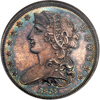 |
1838 Pattern Half Dollar. Silver, reeded edge. NGC graded Proof 64. Nice blue and light gold toning. A very choice example of this memorable design by William Kneass. Liberty is featured with a draped bust wearing a diadem and a ribbon in the hair inscribed LIBERTY. For the reverse, Christian Gobrecht's design of an eagle with spread wings holding an olive branch in the right claw and four arrows in the left.Pop 2; 5 in 65; 1 in 66. (PCGS # 11282) .
Estimated Value $5,500 - 6,000.
View details and enlarged photos
Check results on similar lots
| Realized
$6,670 |
Lot 2285 |
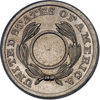 |
1851 Pattern Cent. Copper-nickel, reeded edge, unperforated restrike. PCGS graded Proof 65. Pop 2; probable the same coin. The attempt to produce an acceptable ring cent was continued using a different design but the same alloy and weight as in 1850. The reasons why the ring cent was not adopted are outlined by the Director of the Mint in a letter to the Secretary of the Treasury, dated May 26, 1854. He explained that the cost of recovering the silver would exceed the value of the bullion and that the mechanical difficulties in making ring cents are not trivial. They lie not in planchet cutting but in stamping and ejecting the coins from the dies. I estimate that most of the value of a cent so formed would be sunk in the cost of striking.
All the copper-nickel pieces and all the unperforated ones in this series are restrikes (PCGS # 11558) .
Estimated Value $11,000 - 13,000.
View details and enlarged photos
Check results on similar lots
| Unsold |
Lot 2286 |
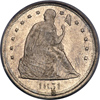 |
1854 Pattern Cent. German silver, reeded edge. PCGS graded Proof 65. Pop 1. Only 1 graded by PCGS. This unusual pattern for an 1854 cent (struck in "German silver," which contains not a drop of actual silver metal) is made in an unusual way. The mint took a silver dollar hub of 1854 and, using a reducing lathe, created a crude transfer die of the desired size. Since this was only to be used to test the German Silver alloy, and never meant for a production coin, the obverse was left unfinished, with resulting concentric lines left by the reducing lathe! (PCGS # 11648) .
Estimated Value $8,000 - 9,000.
View details and enlarged photos
Check results on similar lots
| Realized
$9,775 |
Lot 2287 |
 |
1857 Pattern Cent. Copper-nickel, plain edge. PCGS graded Proof 65. A flashy example. Lightly toned. A few insignificant scattered fly-specks. This delightfully rare pattern cent employs a head of Liberty by Longacre that is instantly familiar as the one he would use in modified form for his three-cent coinage introduced in 1865. Liberty wears a coronet inscribed LIBERTY surrounded by 13 stars. The simple reverse has ONE CENT within an olive wreath, and is the exact design of 1853 (Judd-149 to 151). Very rare with Pop 2 (PCGS # 11815) .
Estimated Value $8,000 - 9,000.
View details and enlarged photos
Check results on similar lots
| Unsold |
Lot 2288 |
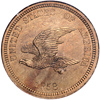 |
1858 Pattern Cent. Copper-nickel, plain edge. NGC graded Proof 65. Pop 5; none higher. Precursor to the now-famous flying eagle cents of 1856-58, this small eagle Pattern comes from the talented brain of the mint's chief engraver at the time (1844-69) James B. Longacre who had a long if sometimes stormy career at the federal mint. Most of these are seen on the standard 72-grain, 88% copper and 12% nickel "white cent" planchets of the period. Notice the crisp detail and broad square rims of the well made Proof (PCGS # 11869) .
Estimated Value $4,500 - 5,000.
View details and enlarged photos
Check results on similar lots
| Realized
$4,600 |
Lot 2289 |
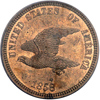 |
1858 Pattern Cent. Copper-nickel, plain edge. PCGS graded Proof 64. Pop 16; 9 in 65; 1 in 66. In 1858 many pattern cents were designed and struck. These were issued by the Mint in sets of twelve. These sets ordinarily contained pieces with 3 obverses; the flying eagle with small letters, the small flying eagle and the Indian head, each combined with the 4 reverses; the corn, wheat, cotton and tobacco wreath, the laurel wreath, the oak wreath and the oak wreath with the broad, ornamented shield. However, at least one set with the large flying eagle with large letters and the 4 reverses were issued. Individual coins from these sets are extremely popular with Pattern collectors (PCGS # 11871) .
Estimated Value $2,200 - 2,500.
View details and enlarged photos
Check results on similar lots
| Realized
$2,415 |
Lot 2290 |
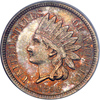 |
1858 Pattern Cent. Copper-nickel, plain edge. PCGS graded Proof 62. The famous 1858 Transitional pattern issue and always popular with cent collectors, even those who are concentrating on building a date set of "regular" issue Indian cents. Attractively toned with excellent eye appeal (PCGS # 11885) .
Estimated Value $1,000 - 1,200.
View details and enlarged photos
Check results on similar lots
| Realized
$1,150 |
Lot 2291 |
 |
1859 Pattern Half Dollar. Silver, reeded edge. PCGS graded Proof 64. One of a pair of splendid silver Anthony Paquet-designed Pattern half dollars we are pleased to offer. Pop 11; 4 in 65 (PCGS # 11960) .
Estimated Value $2,200 - 2,500.
Ex Benson.
View details and enlarged photos
Check results on similar lots
| Realized
$2,070 |
Lot 2292 |
 |
1859 Pattern Half Dollar. Silver, reeded edge. PCGS graded Proof 63. This Type is by Anthony C. Paquet and has a unique version of Liberty seated facing left and supporting fasces with the right hand and a shiled with the left. on the ground lie three arrows and an olive branch; around, thirteen stars; below 1859. Paquet's stylish eagle stands with wings spread, shield on breast, ribbon held in beak is inscribed E PLURIBUS UNUM; holding olive branch in right talon and three long, slender arrows in left (PCGS # 11960) .
Paquet is one of relatively few assistants at the Mint who never achieved the chief engravership position, but whose name is a numismatic byword today. Although he signed many medals at the Philadelphia Mint, including the particularly important Washington Cabinet Medal for presentation on February 22, 1860, his patterns are unsigned. Among patterns attributed to Paquet are certain cent dies circa 1858, this pattern half dollar of 1859, and $20 coins of 1859, several issues of the 1860s, and at least one 1877 half dollar, among others. Dies employing tall letters with thick uprights are often attributed to him, and in the case of certain 1859 half dollars and of the 1861 Paquet Reverse $20 this is correct. Others may have been from punches that Paquet made, but which were employed by different artists.
Anthony C. Paquet was born in Hamburg, Germany, in 1814, and died in 1882.
Estimated Value $2,000 - 2,200.
View details and enlarged photos
Check results on similar lots
| Realized
$2,013 |
Lot 2293 |
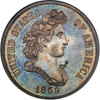 |
1859 Pattern Half Dollar. Silver, reeded edge. NGC graded Proof 64. Nice blue and gold toning. The handsome Longacre design with a head of Liberty crowned with a wreath of oak and vine leaves; a ribbon inscribed LIBERTY around the neck. The reverse of Judd-237 (there were several different reverse dies made for this series of patterns) has the words HALF DOLLAR within Longacre's "cereal wreath" comprising cotton, tobacco, sugar cane, corn, wheat and oak leaves. Pop 5; 6 finer. (PCGS # 11966) .
The handsome Longacre "cereal wreath" is actually the second design of a cereal wreath created by the Mint's chief engraver, 1844-69. Longacre's first usage, which is found on the flying eagle cents, the gold dollars (type 2 and 3) as well as the $3 gold pieces, is comprised of corn, wheat, cotton and tobacco but without the sugar cane or oak leaves.
Estimated Value $2,000 - 2,500.
View details and enlarged photos
Check results on similar lots
| Realized
$2,760 |
Lot 2294 |
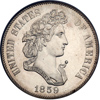 |
1859 Pattern Half Dollar. Silver, reeded edge. PCGS graded Proof 63. Mostly white. Our consignor had a fondness for this 1859 series and acquired several choice examples, of which this is a splendid offering. Pop 17; 13 finer. (PCGS # 11966) .
Estimated Value $2,000 - 2,500.
View details and enlarged photos
Check results on similar lots
| Realized
$2,013 |
Lot 2295 |
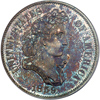 |
1859 Pattern Half Dollar. Silver, reeded edge. PCGS graded Proof 64. Shades of blue and gray toning. A handsome Pattern half dollar any collector would feel proud to own or display. Pop 9; 3 in 65; 1 in 66. (PCGS # 11966) .
Estimated Value $2,000 - 2,500.
View details and enlarged photos
Check results on similar lots
| Realized
$2,760 |
Lot 2296 |
 |
1859 Pattern Half Dollar. Copper, reeded edge. NGC graded Proof 63 Red & Brown. As last, but struck in copper, which has the same rarity rating of Rarity-4. Pop 2; 4 finer in Brown by NGC. (PCGS # 11969) .
Estimated Value $1,800 - 2,000.
View details and enlarged photos
Check results on similar lots
| Realized
$1,668 |
Lot 2297 |
 |
1859 Pattern Half Dollar. Silver, reeded edge. PCGS graded Proof 64. Light golden toning however on the reverse are areas of carker toning. Pop 4; none higher. A total of 7 graded by PCGS. (PCGS # 11988) .
Judd-245 is a mule of the Longacre obverse of 1859 with the Paquet reverse, and is considerably scarcer than many of the other half dollar types issued this year.
Estimated Value $3,000 - 3,500.
Ex H W Bass Jr. Collection.
View details and enlarged photos
Check results on similar lots
| Realized
$3,335 |
Lot 2298 |
 |
1863 Pattern Three Cents. Copper, plain edge. PCGS graded Proof 64 Red & Brown PQ. Old green holder. Pop 2. None higher in RB. A total of 3 graded by PCGS. Obverse and reverse: The dies used to coin regular-issue Proof coins this year. A coin featuring lovely purple to blue brown patina with fire-red accents shining through from below. Outstanding color plus a full strike give it razor-sharpness you have to see for yourself since the detail is amazing (PCGS # 70478) .
Most die trial pieces were made in severely limited numbers. Since these were intended solely to test the dies and there was no consideration give to distributing them to Congressmen so as to influence a decision for a design change, only a small number were made. Judd estimates 4 to 12 known (Rarity-7) for the typical die trial piece. As a consequence, only a small field of collectors can own these at any one time.
Estimated Value $6,750 - 7,250.
View details and enlarged photos
Check results on similar lots
| Realized
$9,430 |
Lot 2299 |
 |
1863 Pattern Half Dollar. Silver, reeded edge. NGC graded Proof 64. Deep blue and lilac toning. GOD OUR TRUST on a scroll above the eagle, this being one of the forerunners to the established national motto which is IN GOD WE TRUST. The obverse of this handsome toned piece uses the regular Proof die. The reverse is almost identical to the regular Proof of 1863 except for the motto. Pop 2; tied for finest graded by NGC. (PCGS # 60500) .
Estimated Value $2,400 - 2,800.
View details and enlarged photos
Check results on similar lots
| Realized
$2,875 |
Lot 2300 |
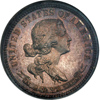 |
1869 Pattern Dime. Silver, plain edge. NGC graded Proof 65. High 6. Nice gold toning on both sides. Pop 5: tied for finest graded by NGC. (PCGS # 60934) .
The theory behind this petite STANDARD SILVER type was to introduce subsidiary coins into circulation. In effect, it was hoped underweight money could be used to replace the hodgepodge of Fractional Currency then clogging the streams of trade. Why reduce the weight? The belief was this would discourage hoarding and exportation as was occurring to our regular issues then being struck. Fortunately this theory never made it into practice; by 1878, gold had returned to par against paper money and small change once again streamed into the country as the squeeze abated.
Estimated Value $2,000 - 2,400.
View details and enlarged photos
Check results on similar lots
| Realized
$1,840 |
Lot 2301 |
 |
1869 Pattern Quarter Dollar. Copper, reeded edge. NGC graded Proof 62 Brown. Rarity High 7. Nice shades of brown and light green with some mint red visable. Pop 1; 1 higher in brown. (PCGS # 60950) .
If in a spare moment you will take time to scan the list of the various Pattern coins struck between 1868 and 1871, you will see a large expansion in the number of types. According to historians, Philadelphia Mint officials were petitioned (often behind closed doors) by collectors wanting a piece of the action. Collectors had heard rumors how privileged individuals were receiving these rare and beautiful Pattern issues. Naturally, they wants some of their own; and for a time the Mint Director and his allies obliged. However, things got out of hand. A ruckus was raised (possibly by jealous outsiders), and the practice of providing specimens ended abruptly. Nonetheless, we can thank these ne'er-do-wells of yesteryear who, through their demands for a slice of the Pattern pie, encouraged a larger number of pieces to be struck than would otherwise have been the case. This relative abundance of dates from 1868 to 1871 keeps prices affordable to the average collector.
Estimated Value $1,400 - 1,700.
View details and enlarged photos
Check results on similar lots
| Realized
$1,668 |
Lot 2302 |
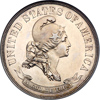 |
1869 Pattern Half Dollar. Silver, reeded edge. NGC graded Proof 63. Nice white example of this pleasing STANDARD SILVER type. Liberty is decked in a stylish liberty cap decorated with two stars; meanwhile, a ribbon inscribed LIBERTY in raised letters extends from the base of the cap across her hair. The designer's initial B within the folds of the ribbon points to William Barber (not his son, Charles) as the origin of this piece. William Barber replaced Longacre as chief engraver upon Longacre's death in January 1869. Pop 3; 7 finer. (PCGS # 60969) .
Estimated Value $2,400 - 2,700.
View details and enlarged photos
Check results on similar lots
| Unsold |
Lot 2303 |
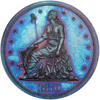 |
1870 Pattern Silver Dollar. Copper, plain edge. NGC graded Proof 66 Brown. Rarity low 7. Wonderful blue and Lilac toning. Pop 1; the only example graded by NGC. Finest graded by either service and, to this cataloger, one of the most beautifully toned Pattern copper pieces ever offered for sale at auction. Judd-999 as this handsome coin is numbered, is the able handiwork of chief engraver at the mint William Barber, who replaced James Longacre early in 1869. Featured is a petite Liberty seated left-facing. She is supporting a shield and liberty cap on a pole with the right hand and holding an olive branch in the left. The reverse uses the modified STANDARD silver back with only the word STANDARD above the wreath (in 1869, and on some 1870 half dollar patterns, this reads STANDARD SILVER). The wreath surrounding the denomination is of cotton and corn. While listed as Rarity 6 in the pattern references (meaning that as few as 13 to as many as 31 may be known) it is with certainty that this lovely Proof 66 is the finest available. The iridescent color, were it not for the photographs, would be difficult to describe properly, they are so beautiful and ethereal! (PCGS # 61246) .
During the late-nineteenth Century it began to occur to the Treasury Department that a subsidiary coinage -- i.e., one in which there is less than full metallic value relative to face value -- was acceptable to the public at large. The reasoning behind this was the public's ready acceptance of Civil War tokens, shin plasters (private bank notes), and Fractional Currency, none of which had any intrinsic value and yet circulated widely. Patterns such as this may have been the American government's first venture into issuing token coinage. By the 1890s, with silver's price declining fast, our fractional denominations had become true token coinage (although still minted in precious metal). It was not until 1965 when clad coins arrived that the government completed the process.
Estimated Value $12,000 - 14,000.
View details and enlarged photos
Check results on similar lots
| Realized
$13,800 |
Lot 2304 |
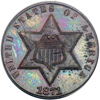 |
1871 Pattern Three Cents. Copper, plain edge. PCGS graded Proof 63 Red & Brown. Old green label. Pop 1; 2 in 64RB. A total of 3 graded by PCGS in RB. Obverse and reverse: The dies used to coin regular-issue Proof coins this year. As you can see by the color photographs, this attractive copper planchet Proof has delightful shades of deep pastels from magenta to sea green with blue iridescence. The few light toning streaks and spotting are likely the only things limiting the grade to below Proof 64 or 65. Razor-sharp throughout (PCGS # 71306) .
Estimated Value $5,000 - 5,500.
View details and enlarged photos
Check results on similar lots
| Realized
$6,613 |
Lot 2305 |
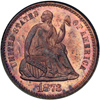 |
1873 Pattern Half Dime. Copper, reeded edge. PCGS graded Proof 62 Red & Brown. Old green holder. Pop 1; 2 graded by PCGS in RB. Another important and highly collectable die trial impression in copper (see the 1871 3c silver struck on a copper plachet offered earlier in the Patterns section). Plenty of mint red left as it deepens to purple brown iridescene in areas (PCGS # 71551) .
Estimated Value $4,500 - 5,000.
View details and enlarged photos
Check results on similar lots
| Realized
$5,175 |
Lot 2306 |
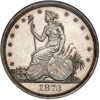 |
1873 Pattern Trade Dollar. Silver, reeded edge. NGC graded Proof 63. Mostly white with a hint of light gold toning. Pop 2; 9 finer. Popular trade dollar pattern (PCGS # 61578) .
Precursor to the 1873-83 issue of Trade dollars, this scarce silver example has a figure of Liberty seated facing left. Her right hand supports a liberty cap on a pole and the left rests on a globe inscribed LIBERTY; behind is a plough with short handles and a small sheaf of wheat, in front are two cotton bales and the sea in the distance. The reverse eagle clasps a shield in one talon and holds a ribbon inscribed E PLURIBUS UNUM on a long scroll in its beak.
Estimated Value $4,000 - 4,800.
View details and enlarged photos
Check results on similar lots
| Realized
$4,025 |
Lot 2307 |
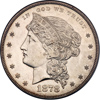 |
1878 Pattern Dollar. Silver, reeded edge. PCGS graded Proof 61 PQ. Old green holder. Pop 7; 26 finer. (PCGS # 61915) .
An attractive Pattern silver dollar designed by William Barber uses a large head of Liberty wearing a coronet inscribed LIBERTY in raised letters; IN GOD WE TRUST above. For the reverse, Barber placed an erect eagle with raised wings holding an olive branch in the right talon and three arrows in the left. E PLURIBUS UNUM is in small Gothic letters above. There are apparently several die varieties of this Type.
Estimated Value $2,500 - 3,000.
View details and enlarged photos
Check results on similar lots
| Realized
$3,220 |
Lot 2308 |
 |
1878 Pattern Half Eagle. Copper, reeded edge. PCGS graded Proof 63 Red. Some minor finger prints left behind light toned spots. Deep fire-red to purple-brown pataina with areas of warm brown creeping in on the head and near the stars on the right side. Pop 1; finest graded by PCGS and the only red example. This strikingly attractive Pattern half eagle is by the mint engraver George T. Morgan. IN GOD WE TRUST appear on the reverse above the eagle in Gothic letters (similar to that of the standard Morgan dollar but without the crossed laurel branches and the stars in the legend) (PCGS # 81940) .
Estimated Value $10,000 - 12,000.
View details and enlarged photos
Check results on similar lots
| Unsold |
Lot 2309 |
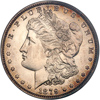 |
1879 Pattern Dollar. Silver, reeded edge. PCGS graded Proof 61. Old green holder. Light gold toning. This is an outstanding design that features the regular die by Morgan for its obverse, with a Barber-designed erect eagle on the reverse. The eagle has raised wings holding an olive branch with seven leaves in the right talon and three arrows in the left. ONE DOLLAR is in small letters below, and IN GOD WE TRUST is placed in the field above. Rarely seen, rarely offered, and a rare opportunity for the Pattern coin specialist. Pop 1; 6 finer. Only 7 total grade by PCGS. (PCGS # 61991) .
Estimated Value $4,500 - 5,000.
View details and enlarged photos
Check results on similar lots
| Realized
$6,038 |
Lot 2310 |
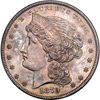 |
1879 Pattern Metric Dollar. Silver, reeded edge. PCGS graded Proof 63. Desirable Metric design struck in silver, designs are by William Barber. Pop 3; 3 in 64 (PCGS # 61996) .
The metric dollar and the goloid metric dollar were designed by William Barber. For the obverse of the metric dollar he used the Liberty head from his rejected silver dollar design of 1878, substituting the motto E PLURIBUS UNUM for IN GOD WE TRUST. As an obverse for the goloid metric dollar he used the same design as on his pattern half dollar of 1877, J-1524. The reverses specified their weight and content.
Estimated Value $2,500 - 3,000.
View details and enlarged photos
Check results on similar lots
| Realized
$2,645 |
Lot 2311 |
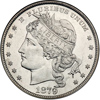 |
1879 Pattern Goloid Metric Dollar. Goloid, reeded edge. PCGS graded Proof 65. Nice white example. A popular, affordable Pattern dollar. Far rarer than would be a Morgan dollar Proof dated 1879, and yet in this grade of Proof 65, the Judd-1626 dollar is actucally much less expensive! Go figure. Pop 3; 6 finer by NGC (PCGS # 62004) .
Congressmen being congressmen, they are prone to formulating every sort of harebrained plan for bettering mankind's condition. Hubbell's "goloid" metal and metric weights and measures scheme was just such a one, and it was a humdinger. Goloid contained a teenie-tiny amount of pure gold; too little to affect the color of the coin which looks suspiciously like plain, ordinary silver. After the Mint struck an assortment of goloid and metric patterns, the whole idea was tossed into the dustbin of history. These few pieces are all we have left as a reminder of Mr. Hubbell's glorious brainchild. (Judd does not supply us with Hubbell's full name, but we do learn through a Google search that Jay Abel Hubbell, a Republican congressman from Michigan, was on the banking and currency committee and so would have a say in defining mint policy.).
Estimated Value $3,500 - 4,000.
View details and enlarged photos
Check results on similar lots
| Realized
$3,910 |
Lot 2312 |
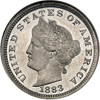 |
1883 Pattern Five Cents. Aluminum, plain edge. NGC graded Proof 64. Rarity Low 7. Mostly white. Pop 1. The only graded by NGC. Rare. Holder reads 1882 the coin is a 1883 (PCGS # 62126) .
This impressive looking adjunct to the standard Liberty nickel series was by William barber. Experiments were taken in 1883 to find a better coinage alloy than the standard 25% nickel, 75% copper alloy we now call "nickel" on the five-cent coinage. Judd-1707 to Judd-1709 has the standard alloy designated on the revere, but this particular variety is struck in aluminum and is therefore extremely rare.
Estimated Value $4,000 - 4,500.
View details and enlarged photos
Check results on similar lots
| Realized
$4,888 |
Lot 2313 |
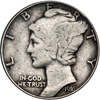 |
1916 Pattern Dime. Silver, reeded edge. PCGS graded Proof 25. Deep gunmetal toning on either side around and within the main devices. Two minuscule nicks on Liberty's neck can be used for future reference, one is at the throat, the other near the tip of the bust near the rim; otherwise the surfaces show no distinguishing marks or other signs of handling other than its use in circulation, which in and of itself seems incredible to a collector of Pattern coins!
One of the great Pattern rarities, the 1916 Mercury Dime is rarely offered because the few known examples are generally kept locked away in large Pattern estates. Perhaps only once or twice in a decade does such a coin get auctioned. This example, Judd 1982, is only the 2nd known example!
The first discovered example, the Robinson/Guth specimen, now graded by NGC PR-12, was reportedly "plucked out of circulation" by a bus driver as reported in The Numismatic Scrapbook, August 1970. Coin World published photos of the Robinson-Guth specimen in the Jan. 14, 1970 issue. The new 8th edition uses wrong photos, this has been confirmed by expert Saul Teichman. This example is a new discovery found June 16, 2004 and only graded by PCGS.
Judd listed all 1916 Mercury patterns under J-1794. The revised Whitman 8th Edition shows as follows:
J-1981: Small head, shifted left, micro date, bust not near rim.
J-1982: Larger head, bust touching rim, micro date, macro motto.
J-1983: Similar large head, separated from rim
J-1984: Virtually identical to the regular issue except for minor differences in positions of the obverse lettering.
Here is an opportunity to acquire the finest known of only 2 examples extant.
The designers of the patterns appearing during this year were apparently influenced by the wars in Europe and this nation's desire for peace.
A. A. Weinman designed a dime in which the obverse was a winged head of Liberty derived from the denarii of Ancient Rome. The designer explained that "the wings crowning her cap of Liberty are intended to symbolize liberty of thought." He selected "the fasces and olive branch to symbolize the strength which lies in unity, while the battle-axe stands for preparedness to defend the union. The branch of olive is symbolical of our love of peace."
In recent years some have expressed surprise that when a new specimen of a 1916 Pattern is discovered it is usually worn, quite contrary to what one expects of a Pattern. The fact is that these patterns so closely resembled the regular issue that they were put into circulation by one owner after another. "It seems obvious," according to Judd, "that there are probably six or more different varieties with about a dozen specimens known overall."
Estimated Value $25,000 - 35,000.
View details and enlarged photos
| Realized
$46,000 |
Lot 2314 |
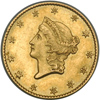 |
1849 $1 Gold Liberty. Open wreath. PCGS graded AU-58. Small head No L. Semi PL. Nicely toned. A nice flow of golden originality from center to periphery marks this as a high-end About Uncirculated gold dollar of the first year of issue. In 1849 there were two styles of Liberty head, this being the more petite of the two, while the second large head seems to fill the field and crowd the stars (PCGS # 7502) .
Estimated Value $400 - 500.
View details and enlarged photos
Check results on similar lots
| Realized
$460 |
Lot 2315 |
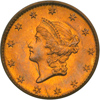 |
1849 $1 Gold Liberty. No L. PCGS graded MS-63. Old green holder. Splendidly lustrous, both sides of this orange-gold example exhibit oscillating cartwheel effects (PCGS # 7501) .
The stars on the Type 1 Gold Dollar comprise a single uninterrupted circle around the coronet-crested head of Liberty. Contrary to the fashion of the period, where the date was invariably fixed below the head, on this denomination the designer, James Longacre, varied the practice and moved it to the reverse, inside the wreath. 1849 dates. Only those of 1849, are found having either a wreath whose ends are nearly in contact at the top or one that is much wider apart, hence the terms "Closed Wreath" or "Open Wreath."
Estimated Value $1,500 - 1,700.
View details and enlarged photos
Check results on similar lots
| Unsold |
Lot 2316 |
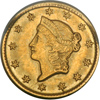 |
1849-O $1 Gold Liberty. PCGS graded AU-58. Heavy with frost but also a shade on the weak side near the rim denticles and stars. The coinage at New Orleans, which tends to be sharp in most instances, probably suffered this year as the mint had to tweak the press to insure proper strike levels from the new design (PCGS # 7508) .
Estimated Value $450 - 500.
View details and enlarged photos
Check results on similar lots
| Realized
$604 |
Lot 2317 |
 |
1850-C $1 Gold Liberty. NGC graded AU-55. Only 6,966 minted. Well struck and untoned. With such a low mintage, the 1850-C date is very scarce, certainly a great rarity in high grades. Pop 6; 40 finer.
Estimated Value $2,500 - 2,800.
View details and enlarged photos
| Realized
$3,450 |
Lot 2318 |
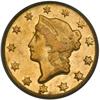 |
1850-D $1 Gold Liberty. PCGS graded AU-58. Light golden toning. Only 8,382 minted. Pop 6; 2 in 61, 1 in 62, 1 in 63. Normal weakness in the centers where the hair failed to strike completely. Also, the upper edge of the coronet lacks clear detail in the beads; stars are mostly flat. The novelty of this denomination's initial year is its extremely low population in high grade (PCGS # 7511) .
Estimated Value $4,000 - 4,500.
View details and enlarged photos
Check results on similar lots
| Realized
$5,175 |
Lot 2319 |
 |
1851 $1 Gold Liberty. PCGS graded MS-63. Weakly impressed in the hair and reverse center; somewhat stained at the lower obverse yet Mint State just the same (PCGS # 7513) .
Estimated Value $600 - 625.
View details and enlarged photos
Check results on similar lots
| Unsold |
Lot 2320 |
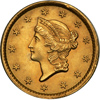 |
1852 $1 Gold Liberty. MS-60 Plus. There is a tiny rim mark on the upper obverse. Struck with methodical precision throughout. Warm coppery orange patina. Minor nick at 1 o'clock obverse rim.
Estimated Value $200 - 225.
View details and enlarged photos
| Realized
$311 |
Lot 2321 |
|
1853 $1 Gold Liberty. Each EF-45. Lot of 2 coins.
Estimated Value $300 - 330.
View details
| Realized
$334 |
Lot 2322 |
 |
1854 $1 Gold Liberty. PCGS graded MS-63. Well struck. In fact, extremely well struck. This little charmer has nice frosty luster and relatively clean surfaces (PCGS # 7525) .
Estimated Value $750 - 800.
View details and enlarged photos
Check results on similar lots
| Realized
$1,064 |
Lot 2323 |
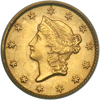 |
1854 $1 Gold Liberty. PCGS graded MS-62. Flowing rivers of golden frost from edge to edge with a distinctive crack in the dies noted from the rim before Liberty's face (PCGS # 7525) .
Estimated Value $300 - 330.
View details and enlarged photos
Check results on similar lots
| Realized
$380 |
Lot 2324 |
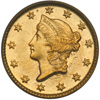 |
1854-D $1 Gold Liberty. PCGS graded AU-58. Well struck with some obverse clash marks as minted. Only 2,935 minted. Pop 7, 10 finer. A lustrous, well struck example with exquisite detain in Liberty's hair plus full stars. Some shallow ghosting around the portrait is from die clash with the reverse; these are faint traces of the wreath impressed into the obverse die. There is a tiny mark above the tip of the coronet. 1854-D is a key date in the short-lived Liberty head Type struck 1849-54. Catalogers always play up its low mintage, which is understandable. Furthermore, a coin of this caliber and with this sharpness provided complete happiness to anyone astute enough to acquire it (PCGS # 7526) .
Estimated Value $7,000 - 8,000.
View details and enlarged photos
Check results on similar lots
| Realized
$7,475 |
Lot 2325 |
 |
1854-D $1 Gold Liberty. PCGS graded AU-55. Lots of flashy lustrous surfaces although there is a small mark on the jaw extending to the throat on Liberty. The 1854-D is a semi-key rarity and the last issuance by this mint of the Type 1 Liberty head design for the gold dollar. With mintage at a paltry 2,935 pieces, and most surviving examples thoroughly worn and in miserable shape, this lovely About Uncirculated stands out for what it is worth, a high-quality bit of eye-candy for the collector of rare gold dollars (PCGS # 7526) .
Estimated Value $6,000 - 6,500.
View details and enlarged photos
Check results on similar lots
| Unsold |
Lot 2326 |
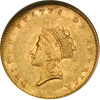 |
1855 $1 Gold Indian. NGC graded MS-61. Light clash marks as made. The desirable Type 2 small Indian head design by James Longacre. Frosty with normal old-gold patina, this scarcer Type was struck to improve the size and appearance of the first, smaller Liberty head dollars of 1849-54. But in doing so, the mint made a mistake by setting the portrait in high relief which caused weak strikes at the centers on both sides. In order to remedy this problem, yet a third style was introduced in 1856. Now Liberty is in much flatter - some say, less elegant - relief and the main defects of striking all but disappeared (PCGS # 7532) .
Estimated Value $2,400 - 2,600.
View details and enlarged photos
Check results on similar lots
| Realized
$3,105 |
Lot 2327 |
|
1855 $1 Gold Indian. EF-45. Some friction on only the highest points and a scattered mark or two.
Estimated Value $240 - 300.
View details
| Realized
$368 |
Lot 2328 |
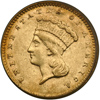 |
1857-C $1 Gold Indian. PCGS graded AU-55. Only 13,280 minted. Pop 9; 6 in58; 1 in 60; 1in 61. This piece acquired natural light toning, and from the moment we saw it, we knew the coin has never been cleaned. Nor has it been mishandled, which is why PCGS assigned the high grade that it did. If you have been troubled looking for an acceptable 1857-C specimen for your date set, look no farther! (PCGS # 7545) .
Estimated Value $2,300 - 2,600.
View details and enlarged photos
Check results on similar lots
| Realized
$5,175 |
Lot 2329 |
 |
1857-D $1 Gold Indian. PCGS graded MS-60. Only 3,533 minted. Light golden toning. Pop 1; 5 in 61; 5 in 62; none finer by PCGS. Normal flat detail on the hair above the brow, the hair curls cascading down the neck, and on the feather puffs -- all due to insufficient pressure from the dies. The rim denticles are typically soft as well, but there is complete, muted luster over both sides. Few collectors ever return from a buying trip bringing with them an early Mint State Dahlonega gold dollar. The simple fact is, these are rare. It doesn't matter whether you can write a check at the tip of a hat. These simply do not appear on the market with any frequency (PCGS # 7546) .
As described in the main section, in 1857, the Dahlonega Mint delivered a mere 3,533 Gold Dollars. Survivors are elusive in all grades according to Doug Winter, and they probably number no more than 120-130 coins (per Winter, 2003). Most often seen in VF or EF grades, the '57-D becomes scarce in the finer circulated grades and downright rare in Mint State as seen in the low population figures.
Estimated Value $8,000 - 8,500.
View details and enlarged photos
Check results on similar lots
| Realized
$8,050 |
Lot 2330 |
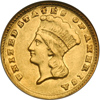 |
1857-D $1 Gold Indian. NGC graded AU-58. Mostly bright. Only 3,533 minted. Pop 25; 6 in 60; 5 in 62. The lustrous surface of this points to its high standing in the About Uncirculated grade class. As seen so often on D-mint dollars of the period, portions of the design appear soft and indistinct, as though from worn dies, including flattened rim denticles. But little matter, given the strict grade from NGC and the recognized rarity due to the small number minted in 1857 (PCGS # 7546) .
Estimated Value $4,500 - 5,000.
View details and enlarged photos
Check results on similar lots
| Realized
$4,600 |
Lot 2331 |
 |
1858-D $1 Gold Indian. PCGS graded AU-58. Only 3,477 minted. Light golden toning. Pop 20; 20 finer. Among Type III Gold Dollars from the Dahlonega Mint, this issue has the third highest mintage, yet so few were coined, is it any wonder that 1858-D would be considered very scarce in higher grade? Choice surfaces that just won't end combines with the attractive color to entice anyone to bid (PCGS # 7549) .
Estimated Value $4,000 - 4,500.
View details and enlarged photos
Check results on similar lots
| Realized
$5,175 |
Lot 2332 |
 |
1859-C $1 Gold Indian. NGC graded AU-58. Only 5,235 struck. Pop 25; 19 finer. Of the 1859-C gold dollar very few were struck. None were numismatically saved at the time, and thus survival of high-end pieces is a matter of chance. For the 1859-C, "high grade" nicely describes anything from AU-58 to MS-61 to 62. The present example is a spellbinder!
Estimated Value $5,000 - 5,500.
Ashland City.
View details and enlarged photos
| Realized
$5,750 |
Lot 2333 |
 |
1874 $1 Gold Indian. MS-60 Plus. The otherwise orange-gold color yields to warmer golden-brown hues in areas. As found on any number of 1874-dated gold dollars, this one was struck from repolished dies in which LIBERTY is almost entirely missing on the headband. We note some fine scratches in the upper reverse fields.
Estimated Value $150 - 200.
View details and enlarged photos
| Realized
$276 |
|
|